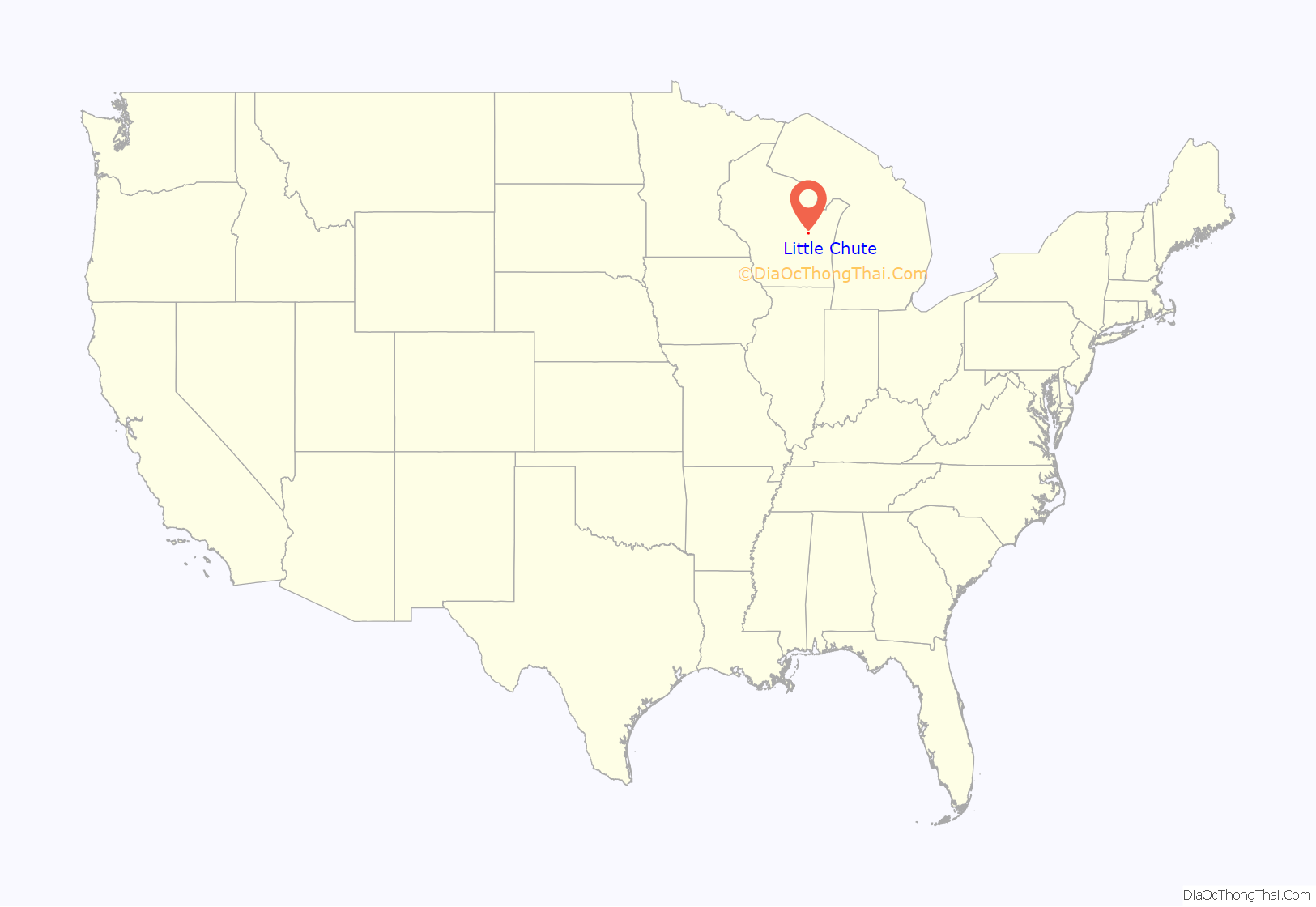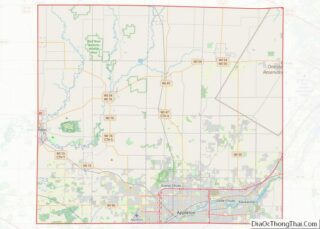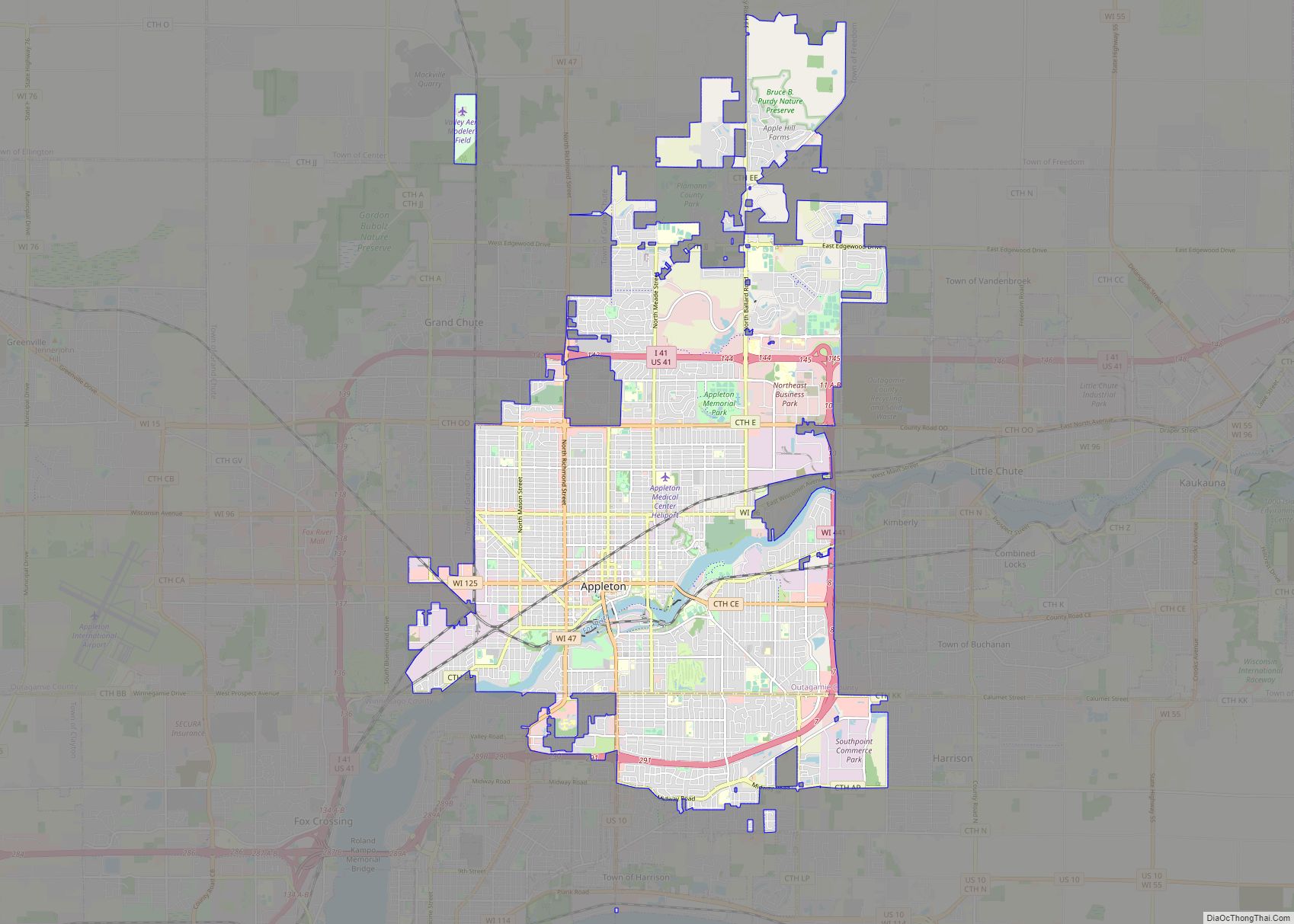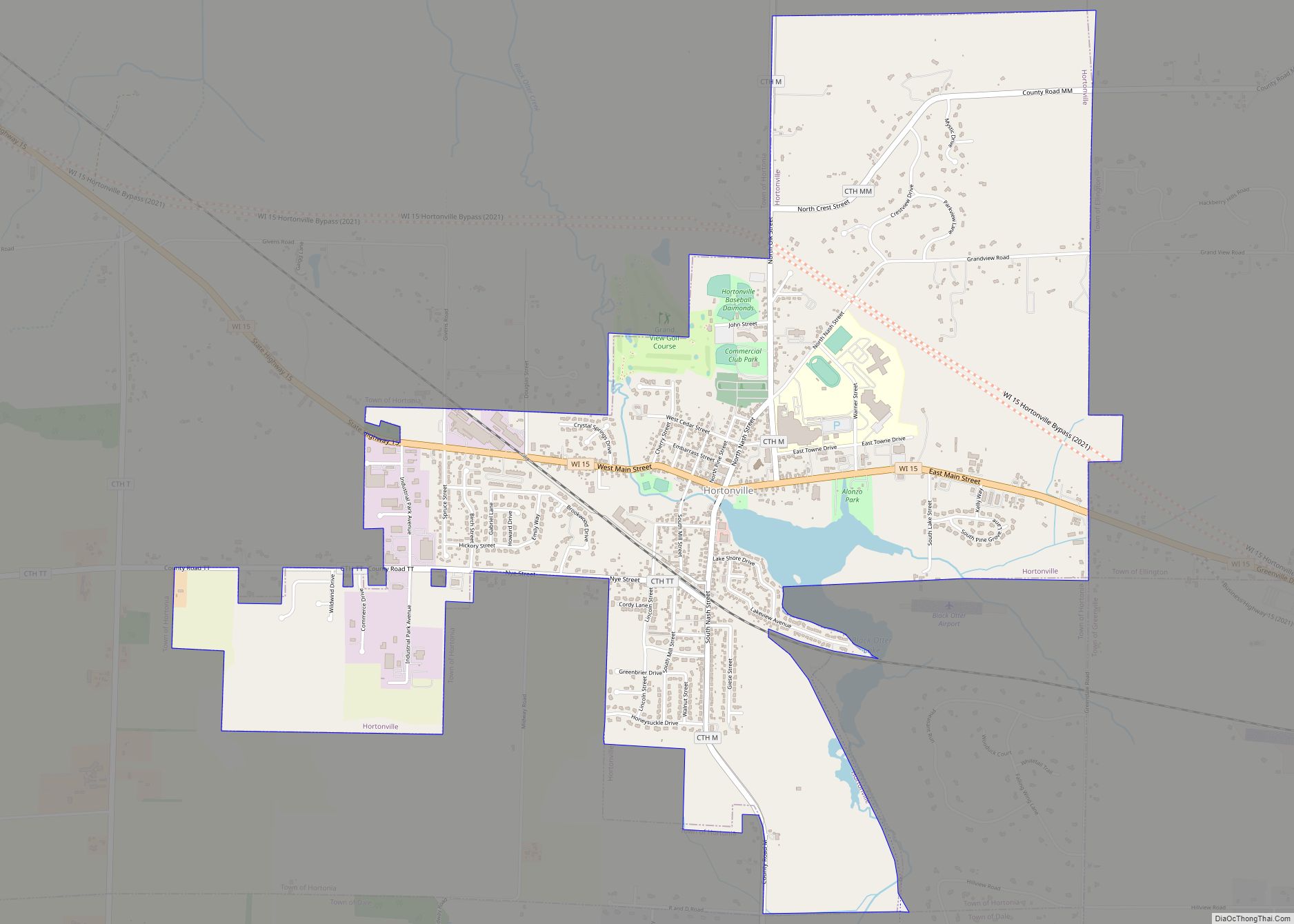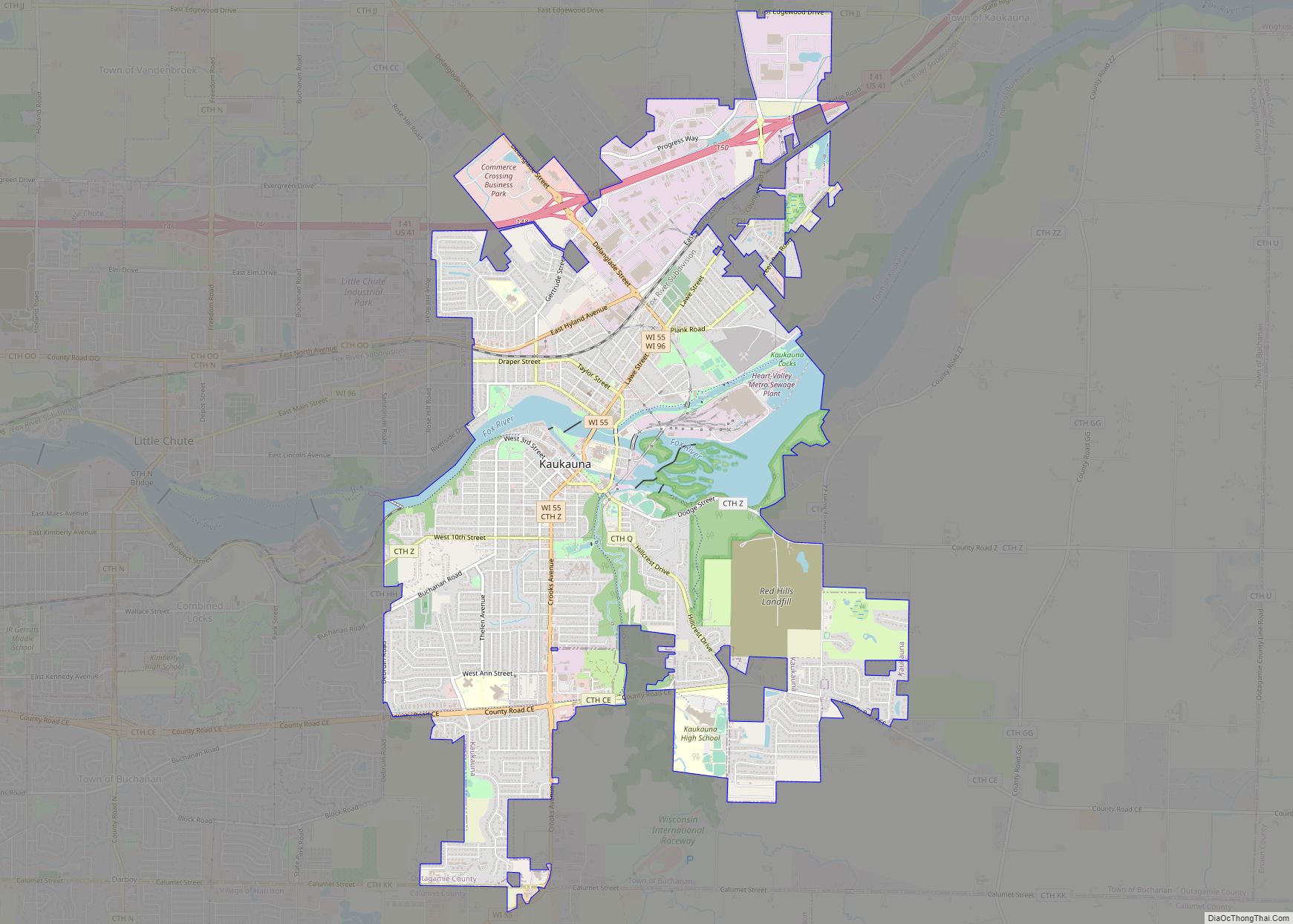Little Chute is a village in Outagamie County, Wisconsin, United States. The population was 10,449 at the 2010 census. It is immediately east of the city of Appleton, Wisconsin and runs along the Fox River.
The town was originally established as a trading post by French explorers who called it “Le Petite Chute” (Little Chute). In the late 19th century, it was settled by Dutch Catholic immigrants from North Brabant, led initially by the Dominican Missionary Theodore J. van den Broek from Uden. The town became an outpost of Dutch Catholic immigrants in the Midwest. Little Chute is home to a full-scale Dutch-style working windmill, which has become a tourist attraction.
Prior to European exploration it is likely the Mississippian culture tribe, the Oneota lived in the area. The Oneota are believed to be the ancestors of the Winnebago or Ho-chunk tribe. A historical marker near Little Chute commemorates the Treaty of the Cedars, a treaty which ceded 4 million acres of Native American land to the US government.
| Name: | Little Chute village |
|---|---|
| LSAD Code: | 47 |
| LSAD Description: | village (suffix) |
| State: | Wisconsin |
| County: | Outagamie County |
| Elevation: | 732 ft (223 m) |
| Total Area: | 6.78 sq mi (17.56 km²) |
| Land Area: | 6.45 sq mi (16.71 km²) |
| Water Area: | 0.33 sq mi (0.85 km²) |
| Total Population: | 10,449 |
| Population Density: | 1,872.44/sq mi (722.92/km²) |
| ZIP code: | 54140 |
| Area code: | 920 |
| FIPS code: | 5544950 |
| GNISfeature ID: | 1568226 |
| Website: | www.littlechutewi.org |
Online Interactive Map
Click on ![]() to view map in "full screen" mode.
to view map in "full screen" mode.
Little Chute location map. Where is Little Chute village?
History
While sharing in the history of northeast Wisconsin, Little Chute has been influenced by two unique factors: the rapids and portages along the Fox River and the coming of Dutch-Catholic settlers in 1848. Prior to and during the early European settlement, the Fox-Wisconsin Waterway to the Mississippi River system was one of the most heavily traveled routes between the Great Lakes and the Mississippi River. Afterward canals and locks were built to circumvent these rapids. The actual construction of these features provided employment to settlers, the Dutch among them, although the canal system never proved to be a great success. In 1836, the Treaty of the Cedars was signed near Little Chute by the Menominee Indians, which ceded to The United States “Four million acres between the Fox, Wolf and Menominee Rivers”.
Native Americans
There is little evidence today of the earliest Native American communities in the area. Prior to the European exploration it is likely the Mississippian culture tribe, the Oneota, lived in the area. The Oneota are believed to be the ancestors of the Winnebago or Ho-chunk tribe; this has yet to be conclusively demonstrated. Regardless, the Ho-Chuck dominated the area just as the French were first appearing in the St Lawrence area far to the east. The Illinois tribe was generally far to the south; the Menominee tribe was just to the north. The Ho-Chuck maintained reasonably good relations with both tribes, although there were several battles with the Illinois. While the French had yet to settle in the area, their presence to the east started a chain reaction of tribal migration. The Huron, Ottawa, Potawatomi, and other eastern tribes all had encounters with the Ho-Chunk. The Sauk and Fox tribes, originally in the St Lawrence Valley, migrated first to southeastern Michigan. The Fox (Renard in French) also called themselves the Meshkwahkihaki and were also known as the Outigamie by the French. The Sac and Fox were uprooted again by eastern tribes and began to arrive in the Fox River Valley in the late 17th century. The Sac and Fox eventually drove most of the Ho-Chunk from the area. When the first French settlers appeared, they named the river after the Fox. The county which today includes Little Chute was to be named Outagamie.
The series of rapids along the Fox River near Little Chute necessitated canoe portages. By the time the French settlement started in the early 18th century, the Sac had essentially set up toll stations along the Fox-Wisconsin Waterway, including the rapids at Little Chute. The French, outraged at the impact on trade, launched a series of attacks on the Sac, culminating in the Fox Wars, which drove them out of the area by 1742. The power vacuum created by the departure of most of the Ho-Chunk, the Sac and the Fox allowed the Menominee to briefly dominate the area. The Menominee set up a village, Ookicitiming (“causeway” in Menominee) near present-day Little Chute.
First European settlement
The first Europeans to the area were the French. Jean Nicolet reached the Fox River at Green Bay in 1634 and set up a trading post. Explorers Father Jacques Marquette and Louis Joliet passed through the area in 1673, following the canoe route to the Mississippi. As early as 1760, the families of Augustin and Charles Grignon, French Canadian Métis, established a fur trade post along the rapids. While French influence waned, it can still be seen in local place names, particularly waterways. Locally the three major rapids on the Fox were named “La Grand Kauklin” (near Grignon’s trading post at present day Kaukauna), “La Petite Chute” (present day Little Chute) and “La Grand Chute” (still the name of the adjoining township).
The French maintained a presence in the area until the end of the French and Indian War in 1763. The area switched to British control until the end of the Revolutionary War in 1781. The Americans nominally controlled the area although the British continued to maintain a presence until the end of the War of 1812 in 1814. In 1787, the area became part of the American Northwest Territory. In succession the area became part of Indiana, Illinois, Michigan, and finally, in 1836, Wisconsin Territories. Statehood was reached in 1848.
Father Van den Broek and the first Dutch settlers
The singular person in the establishment of Little Chute as a Catholic Dutch-American community was a Dominican missionary: Father Theodore J. van den Broek. Born to wealthy parents in Amsterdam, Netherlands in June 1784, he had relatives in Uden, North Brabant, Netherlands and apparently spent time there as a youth. He was highly educated and fluent in six languages. He was ordained a priest in 1808 and joined the Dominican Order in 1817. After a period as a pastor in the Netherlands, he left in 1832 at the age of 49 to join other missionary priests at Cincinnati, Ohio. In 1834 he was ordered to Green Bay to an established Dominican mission. In Green Bay he met the Grignon family, and probably through this contact he went to La Petite Chute in 1836. There he built the first church for the Menominee Indians, St. John Nepomucene, one of several he would establish in the area. Father Van den Broek also met Morgan Lewis Martin, who was in charge of the local canal project. Father Van den Broek purchased land in the area which he later hoped to sell. In that same year, 1836, the Menominees signed the “Treaty of the Cedars” which required them to give up title to the local land and move beyond the Wolf River to the west.
Father Van den Broek began to write letters about the area to groups in the Netherlands. The letters appeared in the Roman Catholic paper, De Tijd (The Times) beginning in 1843. In the summer of 1847 Father Van den Broek went back to the Netherlands to settle his parents’ estate. The settlement was not very beneficial and he found himself nearly destitute. As St. John Nepomucene parishioners were significantly reduced after the Treaty of the Cedars, he used the trip as an opportunity to again write in De Tijd, advertising the mission, the land at La Petite Chute and employment opportunities associated with the Fox River Canal, which included free passage to America for workers. The results were immediate and, by 1848, three wooden sailing vessels called “barks” or “barque” (small three-masted sailing ships), the Libra, the Maria Magdalena and the America, had been booked for passage to the east coast of the United States. Approximate 918 Dutch Catholic immigrants were on the three boats. Most of the early emigrants were from villages near Uden, including Zeeland, Boekel, Mill, Oploo and Gemert. The Dutch economy of the era was stagnant and much of the motivation to emigrate was economic. The emigrants were not poor, as the cost of passage, expenses and land purchase in Wisconsin would have been substantial. They were not, however, affluent and many would have been risking most of their wealth on the chance of economic improvement. There were also political pressures at the time that favored mass emigrations of Catholics.
Typical passage to La Petite Chute included crossing the Atlantic from Rotterdam to New York City, a train trip from there to Albany, a train or Erie Canal-barge trip across New York state to Buffalo, steamship travel through the Great Lakes and Green Bay to the head of the Fox River at Green Bay and finally a 30-mile, ox-cart trip to the mission at La Petite Chute. The first group from Rotterdam arrived on May 22, 1848, led by a Franciscan missionary, Fr Adrianus D. Godthard. Father Van den Broek’s group, held up by an ice jam on Lake Michigan, arrived on June 10, 1848. The emigrants discovered not plowed fields and a village but forested land, being somewhat misled by wording of the De Tijd advertisements: the word “acres” was translated as akkers, meaning cultivated land. There was also not enough good land in Father Van den Broek’s holdings for all the emigrants. There was a resort to drawing straws, with the winners naturally picking the best lots. Many of the others—led by Cornelis van de Heij, a farmer from Zeeland, and Father Godthard—left to form the village of Holland (usually referred to locally as “Hollandtown”) rather than buying the remainder of Father Van den Broek’s land. There were other Europeans, mainly French and Irish emigrants, already established at La Petite Chute, now also known by its semi-anglicized name of “Little Chute.” A few Native Americans still lived in the area.
Later Dutch immigration
Despite the hardships, including the death of Father Van den Broek in 1851, the village prospered. Waves of Catholic Dutch emigrants followed from all over the Netherlands, with whole families and neighborhoods moving to join family and friends already established in Little Chute, Hollandtown, and the outlying farming communities. It is estimated that, by 1927, as many as 40,000 Dutch Roman Catholics had immigrated to the United States—an average rate of 10 per week for 80 years. While many headed for cities or individual farms across the country, Little Chute and the surrounding area represented the largest concentration of Catholic immigrants.
From the start, St. John Nepomucene Church served as a focal point, although other churches would soon spring up in the other communities. The first settlers would have devoted all energies to clearing land, planting, building small homes and barns, fencing and raising livestock. The private Fox River Canal was a failure. The State “Fox and Wisconsin Improvement Company” took over operations in 1850 and finished the canal and adjoining dam by 1856. Railways approached from the south and steamship lines were established on Lakes Michigan and Winnebago. The 16 feet of water head at La Petite Chute and other falls was used for mills, a practice that continues. Little Chute post office was established in 1849. In 1898 the fiftieth anniversary of the founding was commemorated and the surviving “48’ers” recognized. In 1898, residents of La Petite Chute petitioned the State of Wisconsin for incorporation as the Village of Little Chute, which was formally granted on March 8, 1899.
While there are several other Dutch American cities—Oostburg, Wisconsin; Pella, Iowa; Orange City, Iowa; and Holland, Michigan—these were largely settled by Protestants. Little Chute and some surrounding area was largely settled by Catholics. By the early twentieth century it was the largest Catholic Dutch community in the United States. Little Chute remained a Dutch-speaking community—known locally as “speaking Hollander”—into the twentieth century. As late as 1898, church sermons and event announcements were in Dutch. Dutch newspapers continued in the area—mainly in De Pere by Catholic clergymen—were published up until World War I. Speaking Dutch as a first language was common in the area among second and third generation even as late as World War II. The Dutch festival of Sinterklaas was celebrated as “St Nick’s Day” (December 6). This practice continues in many households today. St. John Nepomucene was the primary educational institution with the local public high school not opening until 1966.
Present day
Little Chute celebrated the Dutch festival of Kermis annually from 1981 until 2015. The festival was reinstituted in 1981 after a long hiatus dating back to the early twentieth century, and is possibly the only such named event in the United States. St. John Nepomucene is a thriving parish with recent additions to the church and elementary school.
Little Chute has a full-scale authentic working Dutch windmill operated by Little Chute Windmill, a non-profit organization. The Little Chute Windmill and Van Asten Visitor Center, completed in 2013, serves as a museum and tourist attraction that promotes the history and Dutch heritage of the community.
The Fox River Navigational System Authority is rehabilitating and operating the system of Lower Fox River locks between Lake Winnebago and Green Bay, including the Locks at Little Chute in Doyle Park. Repairs to the Little Chute guard lock, lock and combined locks are scheduled to be completed by 2009. Funding for the bridge at the Little Chute Lock and additional repairs on the Fox River Locks appear to be in question.
While some homes are decorated with windmills and other symbols of Dutch culture, the use of the Dutch language and day-to-day culture has all but discontinued. A tradition from North Brabant, that happens every year in Little Chute is “De Schut” and is a copy of “Koningsschieten” in the province North Brabant in the Netherlands.
The non-profit organization Fox-Wisconsin Heritage Parkway is rehabilitating the Little Chute Lock Tender’s House with volunteer labor and private donations. It will be restored to its 1930s character and will become a vacation rental. The house is on the National Register of Historic Places.
Little Chute Road Map
Little Chute city Satellite Map
Geography
Little Chute is located at 44°17′03″N 88°18′49″W / 44.284087°N 88.313629°W / 44.284087; -88.313629 (44.284087, −88.313629).
According to the United States Census Bureau, the village has a total area of 5.52 square miles (14.30 km), of which, 5.16 square miles (13.36 km) of it is land and 0.36 square miles (0.93 km) is water.
Little Chute is the largest village in Outagamie County
See also
Map of Wisconsin State and its subdivision:- Adams
- Ashland
- Barron
- Bayfield
- Brown
- Buffalo
- Burnett
- Calumet
- Chippewa
- Clark
- Columbia
- Crawford
- Dane
- Dodge
- Door
- Douglas
- Dunn
- Eau Claire
- Florence
- Fond du Lac
- Forest
- Grant
- Green
- Green Lake
- Iowa
- Iron
- Jackson
- Jefferson
- Juneau
- Kenosha
- Kewaunee
- La Crosse
- Lafayette
- Lake Michigan
- Lake Superior
- Langlade
- Lincoln
- Manitowoc
- Marathon
- Marinette
- Marquette
- Menominee
- Milwaukee
- Monroe
- Oconto
- Oneida
- Outagamie
- Ozaukee
- Pepin
- Pierce
- Polk
- Portage
- Price
- Racine
- Richland
- Rock
- Rusk
- Saint Croix
- Sauk
- Sawyer
- Shawano
- Sheboygan
- Taylor
- Trempealeau
- Vernon
- Vilas
- Walworth
- Washburn
- Washington
- Waukesha
- Waupaca
- Waushara
- Winnebago
- Wood
- Alabama
- Alaska
- Arizona
- Arkansas
- California
- Colorado
- Connecticut
- Delaware
- District of Columbia
- Florida
- Georgia
- Hawaii
- Idaho
- Illinois
- Indiana
- Iowa
- Kansas
- Kentucky
- Louisiana
- Maine
- Maryland
- Massachusetts
- Michigan
- Minnesota
- Mississippi
- Missouri
- Montana
- Nebraska
- Nevada
- New Hampshire
- New Jersey
- New Mexico
- New York
- North Carolina
- North Dakota
- Ohio
- Oklahoma
- Oregon
- Pennsylvania
- Rhode Island
- South Carolina
- South Dakota
- Tennessee
- Texas
- Utah
- Vermont
- Virginia
- Washington
- West Virginia
- Wisconsin
- Wyoming
